“Impression, Sunrise” by Claude Monet – Monet’s Sunrise Painting
Impression, Sunrise by Claude Monet is one of the most iconic impressionist paintings. Besides the fact that the artist of this painting is seen as the most prolific Impressionist, Impression, Sunrise is, in fact, the painting that gave birth to this 19th-century painting movement’s name. In this article, we will zoom in on this Monet sunrise painting by doing an Impression, Sunrise analysis and looking at its influences on Impressionism.
Artist Abstract: Who Was Claude Monet?
Oscar-Claude Monet was born in Paris on 14 November 1840. He was born into a shopkeeper family that was neither rich nor poor. After their business in Paris failed, Monet and his family relocated to Normandy where his father experienced more success. Early in his school career, Monet’s love and skill for drawing became apparent. Even though his father raised him to take over the family’s groceries business, Monet desired to be an artist. This created a strain between him and his father.
His relationship with his artistic aunt Marie-Jeanne Lecadre grew during this time – she was a big influence on Monet’s developing art enthusiasm.
During his schooling, Monet would draw caricatures of his teachers and create sketches in his textbooks. The sketches of his teachers were particularly popular among Monet’s fellow students. Luckily, his school in Le Havre had a good art teacher and Monet was further mentored by François Ochard (1800 – 1870). He left school before finishing his final year, to sell his caricatures on the streets of Le Havre.
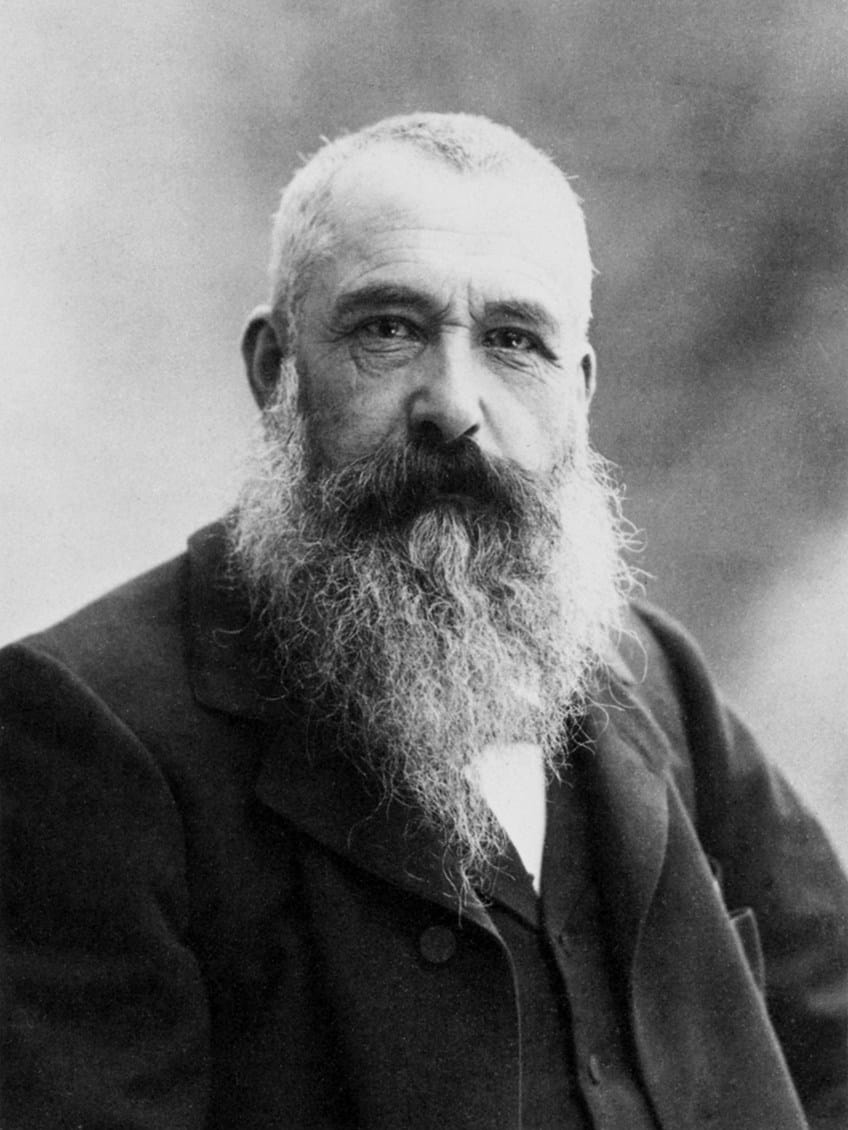
Monet only shifted to painting more serious compositions in 1858, when the artist Eugène Boudin (1824 – 1898) introduced him to landscape painting. He went to Paris to train but did not resonate with the strict and limited training he received under the formal Parisian Salon there.
After briefly serving in the military, Monet returned to Paris and started doing Plein Air painting under the guidance of Boudin.
Under the mentorship of this painter, Monet learned how to capture cloud formations and was introduced for the first time to the project of capturing nature as it is. Before he passed away in 1926, he would push this project to the maximum – attempting to capture the impressions of light and color produced by the sun and seasons changing. This project would lead to him becoming one of the most recognizable Impressionist painters of the 19th century.
Impression, Sunrise by Claude Monet in Context
| Date | 1872 |
| Medium | Oil on canvas |
| Type of Painting | Landscape |
| Movement | Impressionism |
| Dimensions (cm) | 48 x 63 |
| Location | Musée Marmottan, Paris, France |
| Current Value | $250 – 350 million |
Just before Monet painted his famous Impression, Sunrise, he and his wife Camille, and their son Jean moved to Argenteuil. In their home in Argenteuil, Monet would create 100s of his most well-known artworks and some of the most influential Impressionist paintings.
The art dealer, Paul Durand-Ruel (1831-1922) was supporting Monet and his artist friends at the time, which led to the group forming a union and starting to plan their first group exhibition.

All these artists were rejected from the Parisian Salon at the time and decided to do an “out-cast” exhibition. This exhibition did not lead to immediate fame. But did, however, lead to the name “Impressionists” for the group. Under this name, most of the artists that exhibited together in 1874 would eventually receive some recognition for their paintings.
Monet traveled to Paris often and his artist friend, Pierre-Auguste Renoir (1841-1919), regularly came to visit him in Argenteuil.
The two artists went on joint painting excursions in the countryside together and practiced their new style of Plein Air painting that would later lead to the rise of Impressionism in their artistic community. Around the time Monet painted Impression, Sunrise he had a studio boat built for himself. This little boat allowed him to row out onto the water with an easel and painting tools. From this boat, he would paint several landscapes on the water in his lifetime.
Contextual Analysis: A Brief Socio-Historical Overview
The town of Argenteuil was a growing industrial town and only 30 minutes away from Paris. Many Parisians, therefore, visited this town over weekends to relax and enjoy nature. Even though Monet painted beautiful water landscapes around the time he was preparing for the first group exhibition that would lead to the start of Impressionism, the reality was that the Seine (the river close to his home in Argenteuil) was heavily polluted.
This fact is an indication of an important characteristic of the Impressionism movement: this art movement’s focus was on capturing the fleeting impressions of nature.
This mission was not influenced by the political and social environment at all. Even though there was war in Monet’s lifetime, he outlived both his wives, and had to watch his son go to war as well, he consistently painted beautiful scenes of natural landscapes.
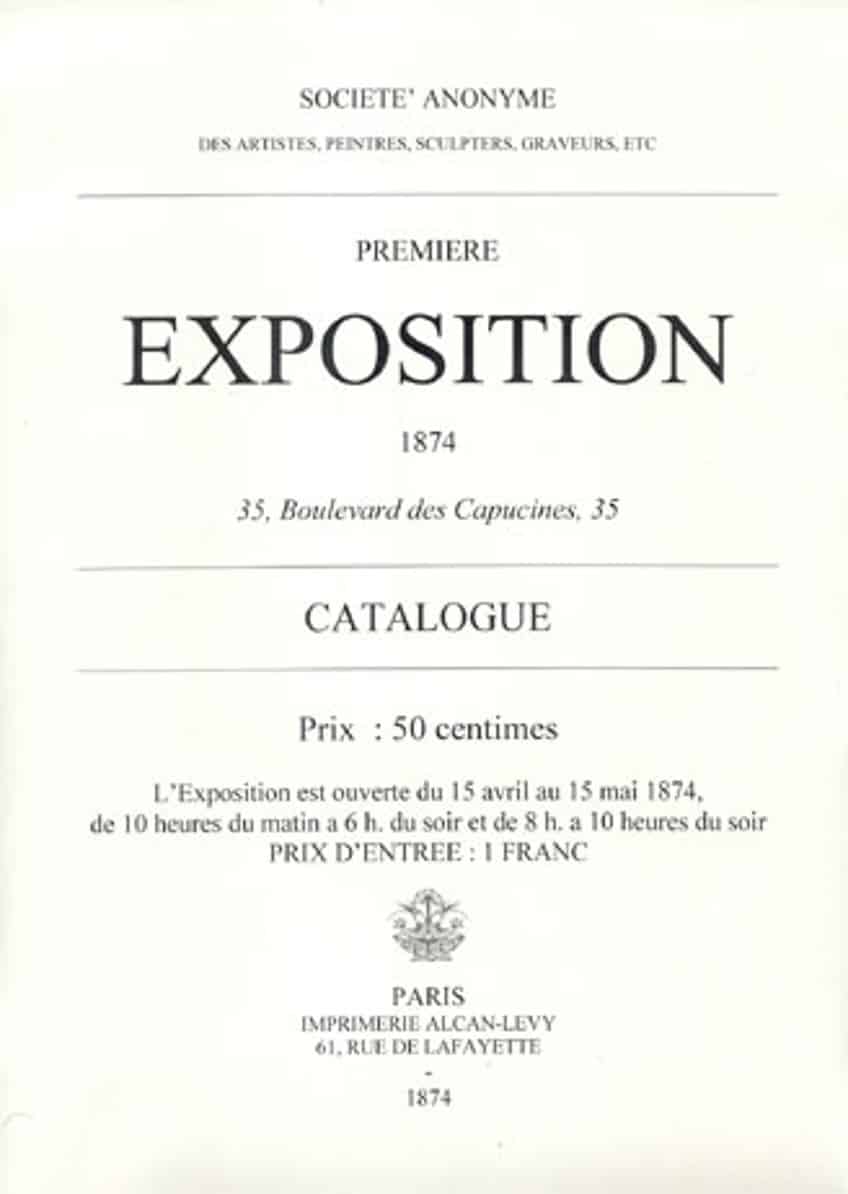
However, when Monet and his painter friends decided to do their first controversial group exhibition together, it was the perfect socio-political movement. The Parisian public was disheartened after the Franco-Prussian war was lost. The country had to give up important industrial areas and pay massive fines to the German Empire.
In an attempt to restore France to its former glory, the government issued a call in a local publication asking artists to help rebuild the county’s cultural righteousness and scholarly greatness by creating special artistic products.
The Parisian Salon responded to this call by putting together an exhibition of glorious war scenes. The public and art critics were outraged by this out-of-touch depiction of French pride. The general feeling at the time was that landscape paintings held more power and sincerity than war or patriotic paintings. This outrage led to artists claiming more freedom to organize independent exhibitions.
Impression, Sunrise Analysis: A Brief Compositional Overview
Impression, Sunrise marks a clear technical split from Monet’s previous works. It is a sketchy painting that has parts of blank canvas sticking out unpainted between layers of soft paint washes. The painting is almost a summary of an experience of a sunrise. In it, we can see a scene of the Le Havre harbor. A bright red sun is rising over boats and the ocean, casting orange and pink smudges of reflection into the sky and onto the water.
Monet himself stated that the scene is not at all a realistic depiction of the harbor in any way. It is an instant painting capturing a moment of changing light – it is almost as if the artist decided to, by chance, capture this natural display over the harbor.
In the foreground of Impression, Sunrise, Claude Monet painted three small boats with fishermen rowing them either toward the right lower corner of the composition or toward the bigger boats behind them. This part of the composition is the most clearly defined, with the last boat in the middle of the composition almost becoming just a smudge. In the background of Impression, Sunrise, Claude Monet painted the shadows of bigger boats resting like ghosts in the harbor.
Their suggested chimneys and masts give us the impression that some of them might be freight boats and others steamships. The fog in this painting reminds us of the paintings Monet created while he was in London and had seen the work of J. M. W. Turner (1775 – 1851), a great influence on Monet’s work. The water and sky meet at the gray bog boats in the middle ground. This compositional choice and the way the colors were mixed by Monet almost confuse the separation between sky and water.
If not for the choppy waves in the foreground, the painting would have the confusing impression that the boats are floating in the sky.
Subject Matter
In Impression, Sunrise, Claude Monet portrayed a peaceful morning scene as much as capturing the impression of the light a sunrise produces. The boats, water, sky, and sun are almost at the service of Monet’s larger study of color and light. The scene is, therefore, not about what is depicted, but entirely about the way it is painted.
The composition reminds us of scenes of the Thames River painted by the American painter James McNeill Whistler (1834 – 1903).

Monet might have met Whistler when he was expatriated from 1870 to 1871 and lived in London. Whistler, like the French Impressionists, believed that painting should exist in its own right – free from being relevant to literature, mythology, history, politics, and so on.
This painting’s subject matter is, therefore, as simple as what you can see and what is evocated in you – the mood created by an artist fascinated with light.
The main characteristic of this painting is the clear execution of it in a single sitting, as well as how it captures only one perception of the scene by showing a brief moment of changing light in time. In that way, it almost acts as a photo snapshot of the view Monet had when he decided to start and finish this work.
Color and Light
The colors in this painting are one aspect that truly sets the work apart from Monet’s previous artworks. The colors are uncharacteristically dark for Monet. It is one of the first paintings where he started experimenting with the effect smoke and fog have on the changing light over a landscape.
The contrast between soft blues, grays, purples, and the bright red of the sun, and the bright orange of the reflection on the water makes the scene all the more striking.
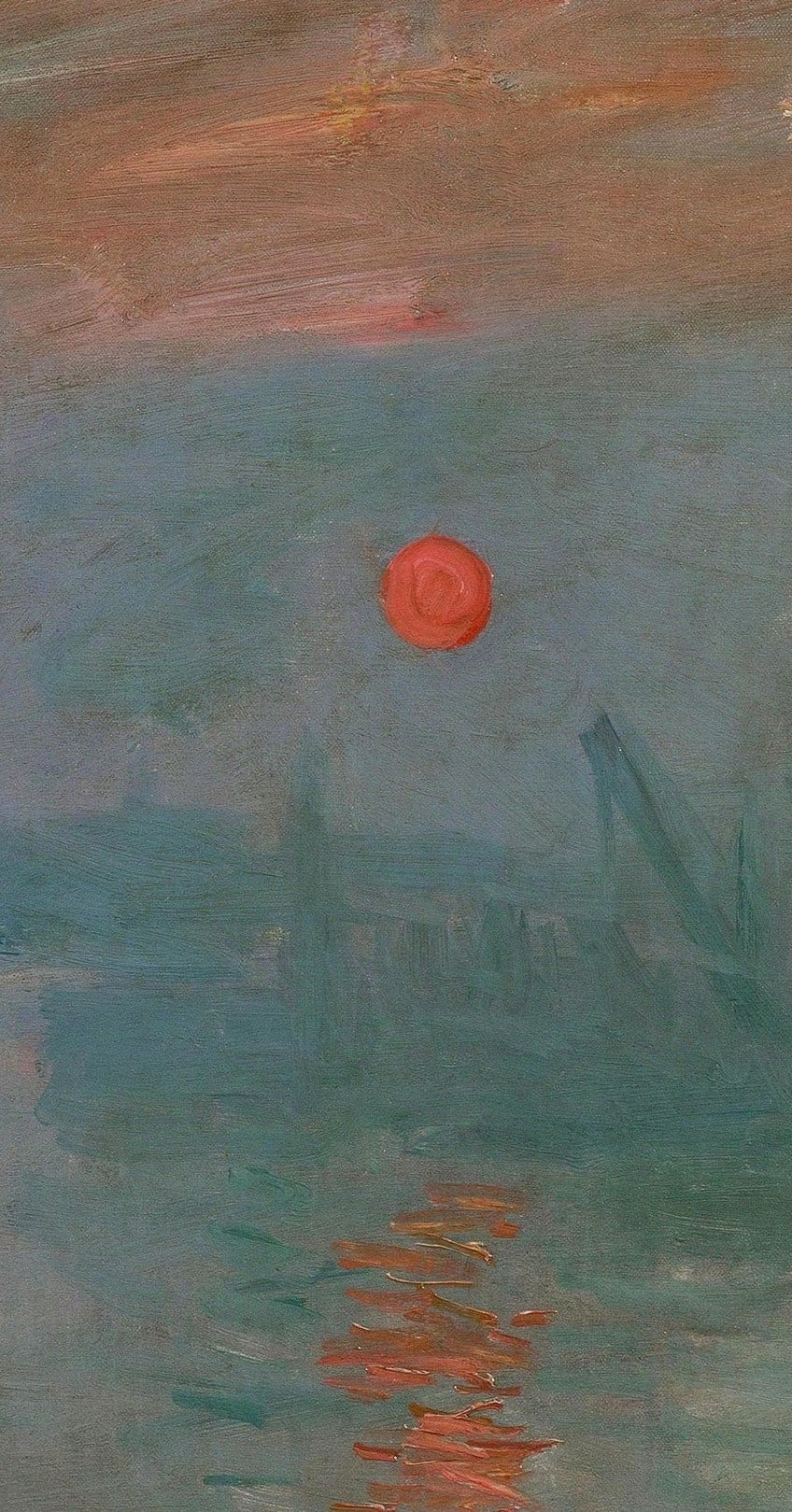
The complementary tones highlight each other and evoke a sense of natural wonder. The darkest note of the painting – the small boat in the foreground – sets the color key for the painting. It also forms a triangle composition between the second boat and the bright sun – bringing a sense of balance to the painting. Another color element that brings balance to the painting, is the brownish color in the top left corner of the painting.
This brown is a mixture of orange and blue-purple tones, creating a middle tone that harmoniously links the color palette together.
Perspective and Space
Perspective and space in this Monet sunrise painting are suggested by the density of marks. The shadowy forms of the ships in the background are painted in dense, flat smudges. Whereas the water in the foreground is painted with a lot of blank spaces in between – with pure canvas sticking out in between in some painted areas. This creates a lot of light tones in the foreground and dark tones in the background.
Another painting technique Monet used to suggest perspective is revealed in the way he painted the small rowboats in the fore- and middle ground.
The boat closest to the viewer is painted in the darkest shade of gray-black. The second boat is painted in a slightly lighter shade, whereas the furthest rowboat is painted in the same shade as the boats in the background. This scaling of shades creates the illusion of depth.
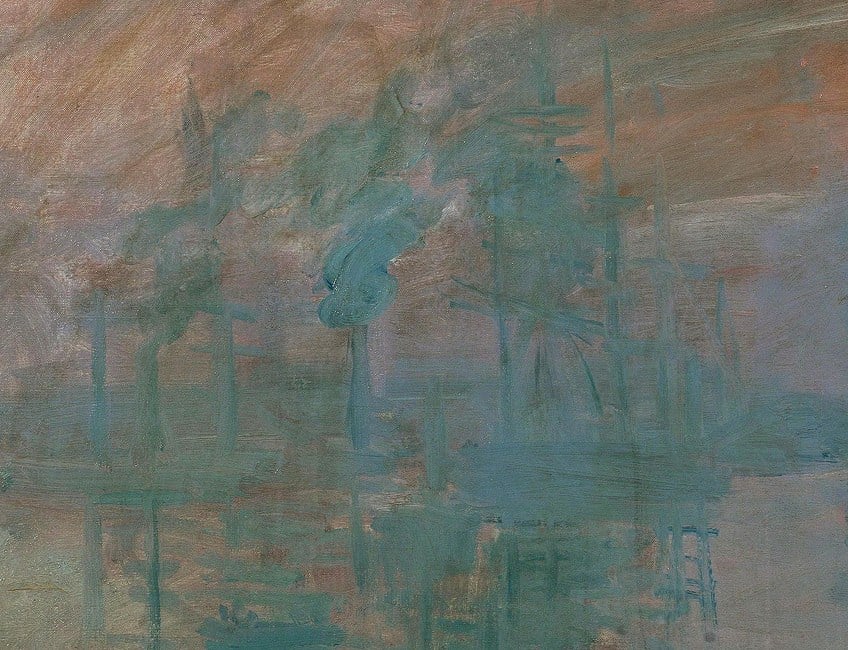
He also painted the elements in the foreground more clearly – the closest row boat to the viewer seems silhouetted and is obviously defined. Whereas the forms in the background of the painting are more blurred and become dissolved in smudges of paint on the canvas.
The reflection of the sun on the water also creates the illusion of depth as the lines closest to the horizon are painted densely together, and towards the foreground, they are spaced out.
In the bottom quarter of the painting, the water is painted to have more movement – as if the viewer’s eye can see more of the detail of the adulating waves. Whereas the water in the middle of the painting is painted with less movement but as having a more general mirror quality, reflecting the bigger boats’ shadows.
Symbolism and Style
If we take the post-war context into account, the rising red sun can be seen as a symbol of the dawn of a new time. It sets the mood of potential in the painting – its vibrant color is representative of the exciting change present in Paris at the time. This reading of the paintings, however, runs against Monet’s otherwise apolitical art.
Besides the fact that this painting led to the Impressionism art movement’s name, it is actually more deconstructed than most of the Impressionist paintings that followed it.
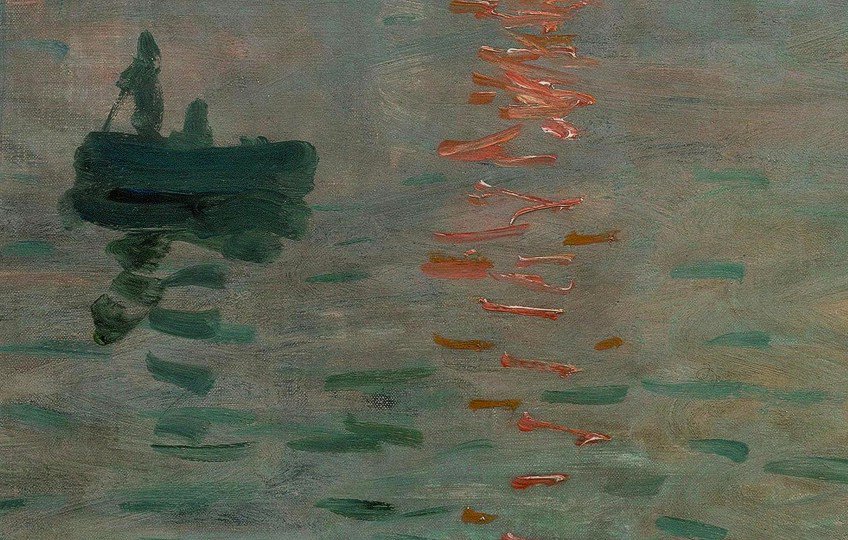
The style is seen as Impressionist but it is far more dismantled, darker, and sketchy than the impasto, bright, and movement-based paintings that Monet created after it. The sketchy nature of Monet’s sunrise painting confirms the fact that it was completed on the spot while the sun was rising over the harbor in real-time.
Process of Creating Impression, Sunrise
As Monet created this painting in one sitting from a window looking out on the harbor, it was created quite quickly and uncomplicatedly. In the right and left lower corners of the painting we can see some underpainting or earlier sketch marks shining through the top layers.
This is further proof that the painting was created with great urgency and immediacy – as if the artist was blown away by the morning’s beauty and quickly grabbed his painting tool to arrest it on canvas.
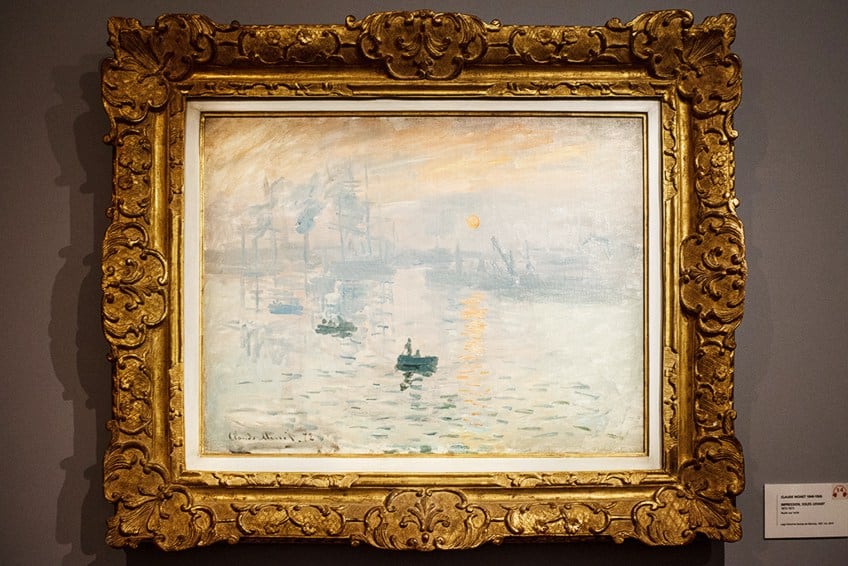
Besides this famous painting, Monet created multiple paintings of the same port at different times of the day. Some of these paintings were created from the waterfront whereas others (like Impression, Sunrise) were created from a building looking over the harbor.
Reception: Why Was Monet’s Sunrise Painting So Influential?
The mission from the beginning of Monet’s sunrise painting was to cause controversy, or at the very least, stir some sensation. The title alone was instigating as it had already been used by an art critic in the judgment of a painting by Charles-François Daubigny (1817 – 1878). This judgment might have been negative, but can be seen as prophetic, as he was criticizing the artist for being happy with only producing a sketchy “impression” of nature and in the process failing to capture the details. This practical philosophy, of course, became the core of the Impressionism painting movement.
Monet’s sunrise painting kickstarted this movement by attaching the name Impressionism to the already practiced philosophy of painting the impressions of nature.
Using the provocative title Impression, Sunrise, led another art critic, Louis Leroy (1812 – 1885), to comment that the artists in the group exhibition of 1874 should be called Impressionists. This was also stated in a derogatory manner, but Monet and the other painters were happy to claim this title for themselves.
Besides the negative critique from art professionals, the public also received the first Impressionist group exhibition (as well as Monet’s sunrise) with mixed and confusing feelings. Some viewers stated that they could not understand what the artist painted and that the smudges and guises of shapes – typical of Impressionism – looked to them like Monet did not finish his painting before putting it up for exhibition. But as we know from studying the trajectory of art history, bad reviews and negative publicity is often as good for artists’ careers as good critique.
Monet and his fellow Impressionists became known for their feathery depiction of light and color, and eventually, Monet reached fame for this contested painting style he became committed to for most of his mature life.
Besides the impact of Impression, Sunrise’s title, this painting was also very influential in terms of pictorial content. It set the tone for artists to create more paintings purely about light and color experiments. It was possible, for the first time in art history, for artists to break away from depicting specific things realistically in their paintings, or being politically and historically relevant.
Impression, Sunrise by Claude Monet initiated the Impressionist art movement during the 19th century. It also influenced artists that came after him to pursue Plein Air painting and experiment more with the effects of light and color. This famous painting changed the course of art history and made Monet the father of Impressionism. We hope that this Impression, Sunrise analysis gave you more insight into this prolific artwork.
Take a look at our Impression Sunrise painting webstory here!
Frequently Asked Questions
Who Painted Impression, Sunrise?
Oscar-Claude Monet (1840 – 1926) is the artist behind the famous painting Impression, Sunrise (1872). He started his art career as a caricature artist in France. He then trained alongside the artist François Ochard (1800 – 1870) and became skilled in Plein Air painting. Monet developed a painting style aimed at capturing changing light and colors during different times of the day and seasons. This style, later called Impressionism, was kickstarted by his painting Impression, Sunrise.
Why Was Monet’s Sunrise Painting So Revolutionary?
Impression, Sunrise (1872) was revolutionary because it was the first time an artist exhibited a painting that was entirely focused on capturing the essence of light and shadow – creating an impression of a landscape instead of a realistic depiction thereof. It also marked the start of artists freeing themselves of being relevant to literature, history, mythology, politics, and so on. It was the first time that artists started claiming the freedom to paint whatever they wanted for whatever reason that made sense to them.
Why Is the Title of Monet’s Sunrise Painting Important to the Impressionism Movement?
In the title, Impression Sunrise, Monet referenced an art critique that negatively judged a landscape painting by Charles-François Daubigny (1817 – 1878) as being merely an impression without any detail. By claiming the word impression in this work, Monet triggered another art critic to comment that the painters in the 1874 exhibition should be called Impressionists. Even though this critic meant the phrase in a negative way, the painters gladly embraced this title, and thereby formally started the Impressionism art movement.
Nicolene Burger, a South African multimedia artist and creative consultant, specializes in oil painting and performance art. She earned her BA in Visual Arts from Stellenbosch University in 2017. Nicolene’s artistic journey includes exhibitions in South Korea, participation in the 2019 ICA Live Art Workshop, and solo exhibitions. She is currently pursuing a practice-based master’s degree in theater and performance. Nicolene focuses on fostering sustainable creative practices and offers coaching sessions for fellow artists, emphasizing the profound communicative power of art for healing and connection. Nicolene writes blog posts on art history for artfilemagazine with a focus on famous artists and contemporary art.
Learn more about Nicolene Burger and about us.
Cite this Article
Nicolene, Burger, ““Impression, Sunrise” by Claude Monet – Monet’s Sunrise Painting.” artfilemagazine – Your Online Art Source. January 10, 2023. URL: https://artfilemagazine.com/impression-sunrise-by-claude-monet/
Burger, N. (2023, 10 January). “Impression, Sunrise” by Claude Monet – Monet’s Sunrise Painting. artfilemagazine – Your Online Art Source. https://artfilemagazine.com/impression-sunrise-by-claude-monet/
Burger, Nicolene. ““Impression, Sunrise” by Claude Monet – Monet’s Sunrise Painting.” artfilemagazine – Your Online Art Source, January 10, 2023. https://artfilemagazine.com/impression-sunrise-by-claude-monet/.



